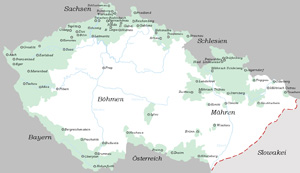1. Map: Areas in the Czechoslovakian state founded in 1918 where the German-speaking parts of the population were a majority
 Click image to enlarge
Click image to enlarge
Questions
Geographical/Historical Context
On 28.10.1918, the Czechoslovakian Republic was founded in consequence of the First World War on the area of the former “Lands of the Bohemian Crown” Bohemia, Moravia and Moravian Silesia, previously governed by the Hapsburgs. The “old Austrians” (“Altösterreicher”) with German origin indeed formed a majority in their areas of settlement by the borders, yet country-wide, they were only a minority (6.8 million Czechs to 3.1 million Germans). The annexation of the “Sudeten German areas” to the German Reich or to Austria failed. On 10.09.1919, the borders of Czechoslovakia (Bohemia, Moravia, Silesia and Slovakia) were set in the Treaty of Saint-Germain-en-Laye. Yet, some areas inhabited by Germans refused to belong to the Czechoslovakian Republic and declared themselves part of German Austria. There were sporadic clashes between Sudeten Germans and Czechs. The situation remained tense.
Answer to the Questions
- In the new state, the German-speaking areas were situated on the margin, by the borders to the German countries. At the same time, the Germans were a minority in Czechoslovakia. In the borderlands of Bohemia, Moravia and Moravian Silesia mainly inhabited by Germans, the majority of the population rejected the inclusion in the new Czech state, since they regarded themselves as Germans due to their culture and language.
- Possible conflicts: Sudeten Germans do not acknowledge the new state; arguments on possession, culture, language etc.; violence and counter-violence; there was propaganda against the others on both sides; wish for inclusion in the German Reich by the citizens of Czechoslovakia with German origin; interference of the German Reich in “inter-Czech” affairs.




Presentation
As early as the Middle Ages, the influx of Germans to the fringes of Bohemia and Moravia lead to a relatively high German part of the population. In 1918, after the collapse of the Hapsburg empire, the Czechoslovakian Republic was founded, in which the Germans formed only a minority. For the Germans in the new state, the term “Sudeten Germans” emerged. The fringes, where they were the majority of inhabitants, were called “Sudetenland”. The low mountain range of the Sudetes extending between Silesia, Bohemia and Moravia was eponymous.